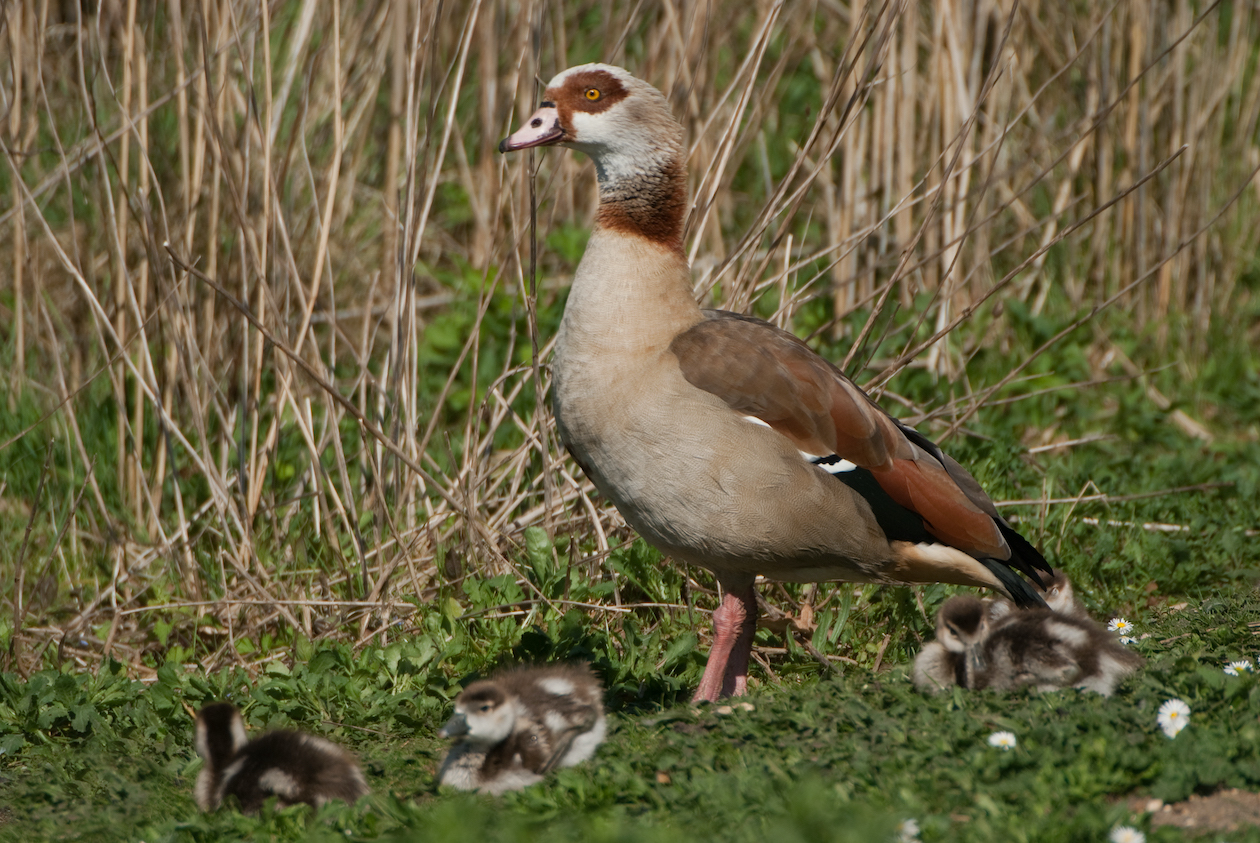Egyptian goose: why it’s more of a duck than a goose
Alopochen aegyptiaca. A goose that is more of a duck and which can leave a sour taste in more ways than one, writes Charles Smith-Jones

Egyptian goose with goslings. The goslings feed on aquatic invertebrates until old enough to graze.
Egyptian goose facts
- Distribution: Occurs naturally across sub-Saharan Africa and the Nile Valley. There are also self- sustaining populations resulting from introductions and escapes in parts of Europe as well as some American states and New Zealand.
- UK Distribution: Resident populations exist mainly in East Anglia and locations along the river Thames, though they may be encountered elsewhere in the Midlands and southern England.
- IUCN Red List status: Least Concern; abundant across much of its range.
- Habitat: Prefers locations offering open water and adjacent short grassland with suitable nesting sites available. May disperse more widely during the winter.
- Food: Feeds on seeds, grasses, leaves and plant stems. Will also take invertebrates such as worms. Goslings feed on small aquatic invertebrates for their first few weeks of life until they are old enough to graze.
- Breeding: Pairs form during the spring after elaborate mating displays, and partnerships usually last for life. Can become fiercely territorial during the breeding season; neighbouring pairs may even kill the offspring of others. The incubation of eggs and the subsequent rearing of chicks is shared by both parents.
- Nesting: Nests can be built on the ground, in hollows such as tree cavities, on ledges or even in the abandoned nests of other birds such as buzzards. They are constructed from vegetation and feathers and sited close to water and grazing sites.
- Clutch Size: Five to 12 eggs.
- Incubation Time: 28 to 30 days. Length (average): 63cm-73cm, females slightly smaller than males.
- Wingspan (average): 110cm-130cm.
- Weight (average): 1.5kg-2.3kg.
- Lifespan (average): Up to 14 years recorded in captivity.
- Shooting Seasons: May be killed or taken in England under the terms of GL40 and GL42.
Egyptian goose – not a UK native
The Egyptian goose is not actually a goose, despite its name and appearance – it is a duck more closely related to our native shelduck. It is also known as the Nile goose for its association with the Nile Valley, where it was once held to be sacred by the ancient Egyptians. (Read more on how to identify different species of duck.)
Non-native to the UK it occurs naturally across much of Africa, where it is the most widespread of the waterfowl wherever there is suitable habitat. The RSPB has estimated that there may be about 1,000 breeding pairs in this country, with many more overwintering. Though birds tend to be loyal to their home ranges and not truly migratory, they may disperse more widely during the winter. (Read our top picks of camouflage jackets.)
Ornamental
The Egyptian goose is popular as an ornamental species and has established itself in the wild here largely as a result of escapes from zoos and other collections. It has similarly colonised other parts of western Europe and elsewhere, adapting readily to many environments. It can be a prolific breeder and has been known to hybridise with other wildfowl species.
Other negative impacts include an ability to out-compete native species for resources and nest sites, where it is noted for its aggression, especially while breeding. In large numbers it can also be responsible for overgrazing, crop damage and has a potential to spread diseases.
For these reasons the Egyptian goose is recognised as an invasive alien under the Invasive Alien Species (Enforcement and Permitting) Order 2019, which enabled wider EU legislation aimed at preventing and minimising the impact of the introduction and spread of non-native animals and plants. It may accordingly be controlled under the provisions of two general licences currently in force.
A distinctive waterbird with a largely light brown body, the Egyptian goose has conspicuous chocolate-brown eyepatches, a similar patch on the chest and a black tail and flight feathers. The white wing patches contrast strongly when seen in flight. The legs and bill are pink. Young geese are duller in colour with a grey tinge to their forewings, a darker crown of the head and neck and yellowish legs and beak. The sexes are similar, with the female only slightly the smaller of the two, and can more easily be told apart by their voices. The noisier goose makes a harsh and raucous trumpeting quack while the quieter gander emits a hoarse hissing sound or a duck-like quack, but also produces a loud honking during its elaborate display ritual.
Encounters
Unlike most other water birds, which are most often seen on the ground or afloat, the Egyptian goose is often encountered perched in trees or on buildings. Though it is quite social for much of the year, once paired for breeding the species can become highly territorial towards others of its own kind as well as other species. Intruders are frequently seen off in spectacular ‘dog fights’ and they have even been known to attack drones that invade their airspace.
Nests may be built on the ground or in burrows but are often sited in tree holes or in the abandoned structures of other birds. Soon after hatching, the goslings leave the nest by simply falling to the ground, their light weight and downy feathers allowing them to do so in relative safety. The parent birds call from below throughout in encouragement but offer no other assistance. The young are precocial and, though protected and cared for by their parents, start to forage for themselves immediately.
Opinions regarding the Egyptian goose’s qualities as a table bird seem to be widely divided. Some consider it rich and gamey, while others are less impressed and suggest various recipes along the lines of marinating the plucked bird overnight in red wine and brandy before wrapping it in bacon and roasting, only then to throw the bird away and enjoy the bacon with a glass of the gravy. Perhaps Sporting Gun readers who have had better success can share a suitably tasty way of preparing one? (You can find our duck recipes here.)








